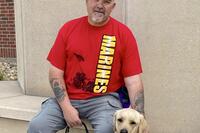Stories of heroism in combat abound, but not many of them tell the tale of the hero's homecoming. Marine Corps Sgt. Albert A. Schmid's story not only follows him home, it tells the truth about what happened to him on Guadalcanal in 1942 and after.
Al Schmid grew up in Philadelphia and met Ruth Hartley in 1940; he was working at the Dodge Steel Company and she was a salesgirl at Sears. Schmid fell madly in love with his "Babs," and on Dec. 7, 1941, he was getting ready for a date with her when he heard the news that the Japanese had attacked Pearl Harbor. He enlisted on Dec. 9, and on Jan. 5, 1942, he left Philadelphia for recruit training at Parris Island, South Carolina. On his short leave before leaving for "Destination Unknown," he used his Christmas bonus to buy Hartley an engagement ring.
Soon after, as part of the 11th Machine Gun Squad, Co. H, 2nd Battalion, 1st Regiment, 1st Marine Division, Schmid became part of the largest Marine force ever engaged in landing operations. They assaulted Guadalcanal in the first American offensive against the Japanese. After one buddy was killed and another injured, Schmid was left loading and firing a machine gun for more than four hours. Then came the Japanese grenade that would take Schmid's sight -- but not his courage.
Shouting at an injured friend to "tell me which way [they're] coming from and I'll get [them]," he resumed firing, sightless. After the field cleared on Aug. 21, Marines on the scene credited Schmid with 200 kills. He received the Navy Cross while recovering from numerous operations on his face and eyes. A nurse at the San Diego naval hospital wrote to Hartley and told her that Schmid's chances of seeing again were not good.
Hartley, however, refused to allow blindness to stand in the way of happiness. She married Schmid in April 1943, and their son Albert Jr. was born the following year. Schmid was showered with attention and honors, and Roger Butterfield wrote a book called "Al Schmid -- Marine" that became a movie, "Pride of the Marines."
Released in 1945, the movie was an instant hit -- but not because of its combat scenes, which comprise only 10 minutes of the film. People responded to this moving, honest portrayal of Schmid's recuperation and efforts to adjust to life as a visually impaired man. And adjust he did, living in St. Petersburg, Florida, and pursuing hobbies like ham radio and fishing. Schmid died on Dec. 1, 1982, and is buried in Arlington National Cemetery.
Want to Know More About the Military?
Be sure to get the latest news about the U.S. military, as well as critical info about how to join and all the benefits of service. Subscribe to Military.com and receive customized updates delivered straight to your inbox.















